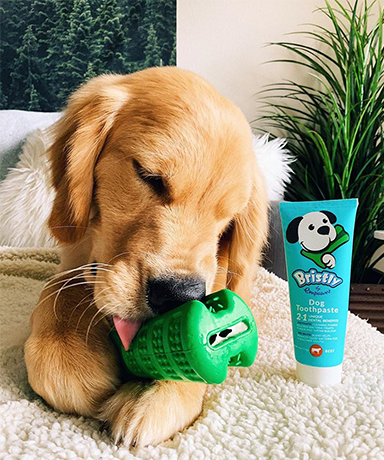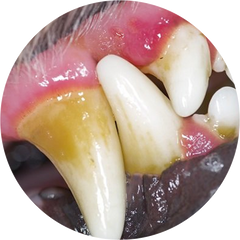Your Cart is Empty

Time to make your inbox pawsome
Sign up today and get 10% OFF your first purchase!


Dog dental care is important. While there are benefits to keeping up with your dog’s oral health like fresher kisses, proper oral care can even save your pup’s life.

By the age of three, most dogs have some signs of Periodontal Disease, also known as Gum Disease. If periodontal disease is not treated effectively, it can cause problems as severe as internal organ damage and death.
The good news is that periodontal disease is preventable with a good oral health system in place.
Regular brushing is the only safe and effective way to prevent gum disease, but there are a lot of myths out there that will have you believe otherwise.
Below are 5 myths we hear all the time about dog oral health:
Many pet parents have heard that feeding dogs a raw diet is a healthy way to improve their oral health. According to Dogs Naturally Magazine, “Raw meaty bones provide an active chewing and gum cleaning advantage.” While this diet may be beneficial, there are health risks to consider with a raw diet:
You risk an unbalanced diet. An unbalanced diet means that your dog isn’t getting all of the proper nutrients they need to stay strong and keep their teeth healthy.
Food poisoning is another concern. In fact, the CDC is against feeding raw food to dogs because of this risk. You may not think dogs can get food poisoning, but just like humans, they can get salmonella.
You wouldn’t stop brushing your teeth because of your diet and neither should your dog.
This one is tricky. While there are many brands out there that claim their treats will effectively improve dog oral health, there are few ways of knowing if that statement is true. That’s where the Veterinary Oral Health Council(VOHC) comes in. The VOHC “recognizes products that meet pre-set standards of plaque and tartar retardation in dogs and cats.” This means that they perform trials and if a product claiming to remove plaque meets these standards, they are awarded the VOHC Seal recognizing that they benefit oral health.
While this may sound like good news, let’s think about how long your dog actually takes to chew a treat, if they don’t gulp it down immediately. If they’re not chewing the treat, they’re not getting any of the benefits implied by the VOHC Seal. After all, it is the simple motion of chewing that breaks down plaque and tartar.
Would you trust a quick snack over daily brushing? Your dog wouldn’t either.
Bones may just be the most common chew toys in pet parent homes as most dogs love to chew. According to the Windmill Animal Hospital, bones can “remove some of the soft food particles of the previous meal from the dog’s teeth and gums, but dog bones CAN NOT remove existing tartar.”
While it is true that regular bone chewing can help remove food particles, it only removes these leftovers in the areas that the bone is rubbing against the tooth. Your dog may have a favorite chewing position and only chew on one side, unable to get their back teeth.
Imagine yourself chewing on a bone. When you’re done chuckling, think of all the spots you’re not reaching in your mouth. The same goes for your dog.
We also have to remind you that bones can be dangerous. Bones can break and splinter, getting lodged in your dog’s throat, digestive tract, and intestines. Bones may also be too hard for your pup and cause tooth fractures. In fact, chewing bones may even make your dog’s oral health worse. The Windmill Animal Hospital says, “the gnawing action shears off the tartar and drives it into the gums.” This can cause pain, swelling, and even bleeding in your dog’s gums.
Bones may be fun for your dog, but they’re not the best way to remove plaque, tartar, and prevent gum disease.
This statement is absolutely false. What most pet parents don’t know is that gum disease is virtually undetectable until it’s too late. According to the AVDC, “By the time there are obvious indications of periodontal disease, such as bad breath and loose teeth, there is already significant damage.” This means that once you start noticing issues in your dog’s mouth, they may already have periodontal disease. This sneaky disease starts below the gum-line, where you can’t see it.
Prevention through daily brushing is the only way to tackle gum disease and visiting the vet for yearly checkups is the only way you can truly know if your dog has periodontal disease.
Although puppies don’t have their adult teeth yet, getting them used to regular brushing is the best way to ensure proper dental hygiene through adulthood. Think of them as children, we know you probably do already. Children learn early on how to brush their teeth so that when they’re older, they’ll continue the routine and continue to have healthy teeth. Even though the teeth fall out, it’s important to massage and clean the gums so that the new teeth will come into an already healthy environment.
According to the Milford Animal Clinic, “Brushing your puppy’s teeth between the ages of eight and sixteen weeks is critical and it will make the job easier when he is an adult”. By teaching a dog what brushing is like, no matter what the method, and how often it’s done, puppies will get used to the idea and more easily accept this part of their daily routine.
This myth may just be the biggest offender on our list. How many times a day do you brush your teeth? We’re hoping it’s at least twice a day. Why should your dog be any different? Brushing is the best way to scrub away plaque and tartar from all or most of your dog’s teeth, accomplishing what chewing on hard bones and treats can’t.
According to the Animal Medical Center, a study was done that proved brushing more frequently was the best method of preserving dogs’ oral health. They said, “Just like your dentist tells you, daily brushing resulted in cleaner, healthier teeth and gums.” Let us repeat that: The most effective way to reduce plaque and tartar, and prevent gum disease is daily brushing.
Daily brushing can save your dog’s life.

This one is actually true. Brushing your dog’s teeth daily IS hard for you, but it doesn’t have to be for them. Have you ever met a dog who let his owner brush his teeth? Neither have we. Once you pull out your dog’s toothbrush, they probably run and hide in another room, or run around the house until you get too tired to keep trying. Many pet owners give up after that and their dogs never get the proper dental care.
We have good news for you. As pet parents, we know your struggle, so we did some research and found a product that will actually debunk this myth. The Bristly Brushing Stick allows dogs to take their oral health into their own paws! This no-thumbs-necessary brushing stick allows your dog to chew and play the plaque away, just add doggy toothpaste and you’re ready to go. This should be your dog’s new daily brushing routine.
